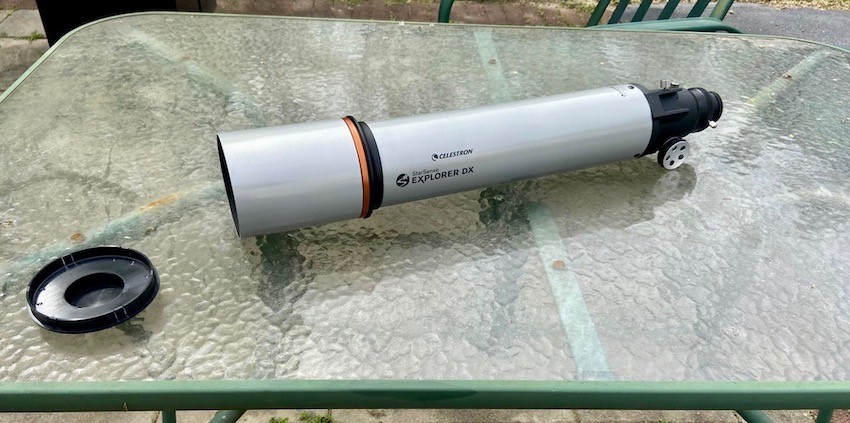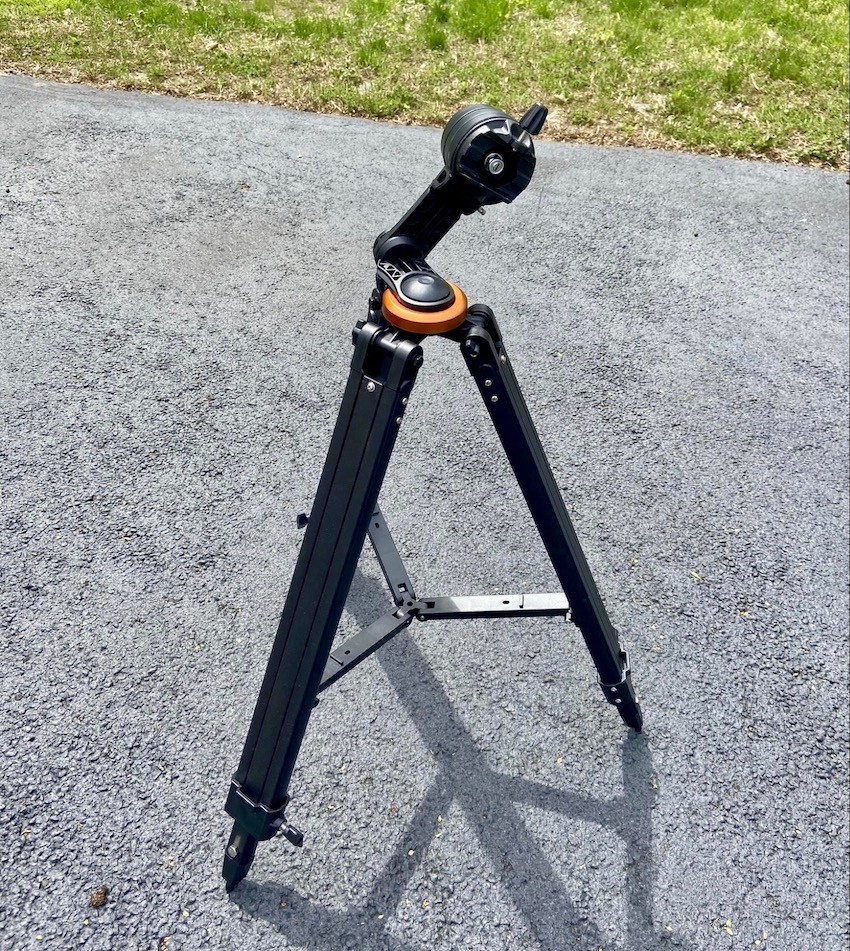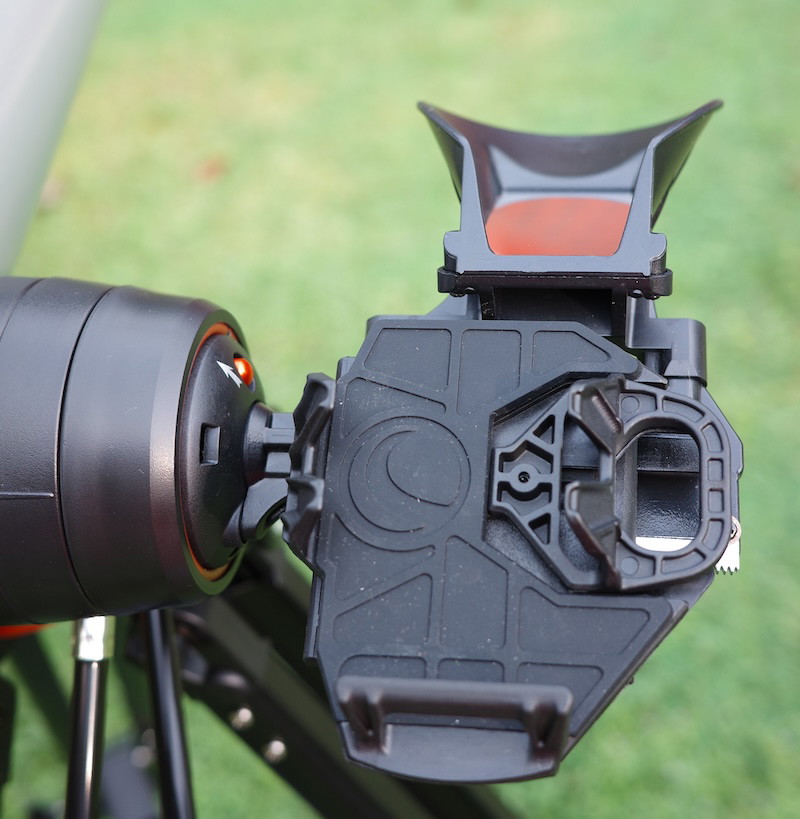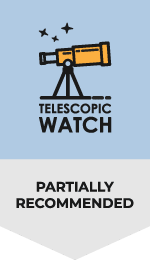The Refractor OTA and the Focuser

The Celestron StarSense Explorer DX 102’s optical tube is a 102mm f/6.5 refractor with a focal length of 650mm, the same as I’ve seen being used on many other Celestron telescope/mount packages like the NexStar 102SLT. At its given aperture and focal ratio, I’ve observed a fair amount of chromatic aberration as expected, though sharp views of the Moon and planets were still possible.
Even though the DX 102 has a 2” rack-and-pinion focuser, when I use some of my 2″ eyepieces on the focuser, I’ve noticed that the tube can’t actually balance on its mount. So in practice, I’d consider that the scope to be limited to 1.25” eyepieces and accessories only. Thankfully, even with 1.25” eyepieces, I can squeeze out a field of view of about 2.5 degrees with a 32mm Plossl or similar. So this should not be of huge concern to a beginner.
A Fair Alt-Azimuth Mount

The StarSense Explorer DX mount is nothing more than a repainted Omni XLT AZ or “AZ3” mount with a bracket for the StarSense Explorer device. This mount is a little on the small side for the optical tube, but I think it works just fine.
It’s a simple aluminum-legged alt-azimuth mount with a pair of slow-motion controls for fine adjustments on both axes. That being said, I find the backlash from these slow-motion cables annoying when I’m using the scope at high magnifications. It’s also not as intuitive as a simple Dobsonian mount, for instance.
I appreciate the accessory tray; it’s a nice, sturdy component and an actual tray, unlike the silly eyepiece rack supplied with many scopes (which I have never understood the point of; it’s just a great way to get your eyepieces damaged and have them dew up faster).
One minor complaint about the mount, and one that bothered me especially with my sample: I couldn’t adjust the tension/friction on either axis without a socket wrench, and even then, it was very difficult. My mount came EXTREMELY overtightened to the point that I could not actually move the scope in altitude, and it took me a fair bit of strength, some disassembly of the mount and overall around half an hour of work to fix. Adjusting the azimuth axis involves just popping off a small plastic cover on the center of the mount and loosening/tightening the lock nut as needed with a socket wrench/screwdriver.
The Accessories with the StarSense Explorer DX 102AZ

The StarSense Explorer DX 102 includes two 1.25” eyepieces: a 25mm “Super” Konig providing 26x and a 10mm Konig providing 65x. I believe they are by far the weakest links in the scope.
These eyepieces have a lot of plastic in their build but use glass optics and are fairly sharp, with more eye relief than a typical Plossl ocular (I find this particularly beneficial with the 10mm). I also noticed some issues with glare and ghosting, and they are slightly inferior in sharpness to a true Plossl design.
Though both eyepieces are comfortable to use and work well, for the price Celestron is asking for the DX scopes, I would really like it if they provided even slightly better eyepieces.
The DX 102, being a refractor, of course comes with a star diagonal—Celestron’s standard, nearly all-plastic 1.25″ Amici prism star diagonal. It works fine and provides a correct left-right/up-down view, but it has some issues with glare and a diffraction spike on bright targets. I would recommend replacing it once you’ve taken care of the eyepiece situation. However, it’s enough to get you started.
It also comes with Celestron’s standard “StarPointer” red dot finder, which I see on pretty much all beginner telescopes these days. It is actually somewhat redundant with the StarSense Explorer technology, but I appreciate its inclusion.
The StarSense Explorer Technology
At its core, the StarSense Explorer actually uses a relatively old technology known as plate-solving. In essence, what it does is take a snapshot of the sky and use computer algorithms to figure out where it is pointing. Normally, this is done for astrophotography to avoid performing a time-consuming GoTo alignment and is only used to find one target.
In principle, the StarSense Explorer tech is basically a bracket to point our phone at a small mirror that has been aligned to the telescope mount and then uses the phone’s onboard camera and processing power to plate-solve.

Because of our phone’s limited battery life, the StarSense Explorer technology can’t take a new picture of the sky every time we move the telescope. It would kill our phone quite fast. Instead, it uses plate-solving technology only when we first set up the telescope or when we move it across a significant portion of the sky. Other times, it tries its best to extrapolate finer movements using our phone’s relatively inaccurate gyroscope and accelerometer.
In practice, I’d say that this system is limited to an accuracy of about 0.25 degrees, or half the width of a full moon. Although this is much less precise than a real GoTo system with tracking, it is much simpler, easier, and more reliable than a motorized GoTo telescope.
The StarSense Explorer App & Interface
The StarSense Explorer app is ridiculously easy to set up. All I need to do is install the app, enter the unlock code that came with the telescope, and dock the phone to the telescope. The bracket fits most phones and works just fine even if I have a relatively thick case (or even a PopSocket, which I was shocked by). Once I undergo a super-simple alignment procedure, the StarSense Explorer app has thousands of objects it can find for me—the Moon, planets, most of the Messier catalog, and many more. Overall, I like it for what it does.
I’ve seen people on astronomy forums and contacting Celestron themselves, asking why the bracket and code cannot be sold as a stand-alone item. Celestron’s main explanation is that many beginners would buy the bracket and attempt to fit it onto substandard telescopes (or simply do it improperly) and become frustrated. I kind of agree with this sentiment.
I previously used to complain about the lack of targets in the app’s database, but Celestron has updated the app and drastically expanded its number of objects, greatly increasing its overall utility.
Should I buy a used StarSense Explorer DX 102AZ?
A used StarSense Explorer scope will likely be missing the code for the app and many of the scopes floating around have had their phone brackets yanked off as well for use on other instruments. So unless you can be sure it has those or the price is absurdly low, I’d recommend you pass.
Alternative Recommendations
There are some other manual as well as computerized scopes in the DX 102 AZ’s price range that you might want to take a look at:
- The Apertura AD8 has nearly double the aperture, significantly better accessories, and a simpler mount than the StarSense Explorer DX 102 AZ. You can actually buy digital setting circles/encoders such as the Romer Optics EZ Push To that basically emulates the StarSense Explorer setup with your phone.
- The Sky-Watcher Virtuoso 150P has more aperture than the DX 102 AZ but without the chromatic aberration and in an extremely compact package, with full GoTo and tracking operated by your smartphone along with the ability to be aimed manually. The all-manual Heritage 150P is identical but lacks electronics.
- The Celestron Astro-Fi 130 P has a bit more aperture than the DX 102 AZ and will automatically aim around the sky via commands from your smartphone and track objects without any manual adjustment. The Astro-Fi requires a full GoTo alignment to use and is mounted atop a tripod.
Aftermarket Accessory Recommendations
A new star diagonal is probably the #1 thing you can do to improve the StarSense Explorer DX 102’s performance.
Celestron’s 1.25” prism is pretty good; a dielectric unit like Apertura’s improves performance and won’t scratch your eyepieces thanks to the equipped compression ring adapter. A 2” diagonal and eyepieces would allow for a wider field of view but are expensive and would make the scope unable to properly balance on its mount, as well as straining the lightweight mount and tripod.
A 6mm “gold-line” eyepiece will provide 108x with the StarSense Explorer DX 102, which is near the upper bounds of what the optics of this telescope can handle. It’s a good magnification for viewing the Moon, planets, smaller deep-sky objects like globular clusters, and splitting double stars. A 32mm Plossl will provide 20x, with a slightly wider true field than the included 25mm ocular, but is of debatable usefulness.
What can you see with Explorer DX 102AZ?
The StarSense Explorer DX-102 is limited to brighter objects by the nature of its small aperture.
- The Moon looks pretty good, while Mercury and Venus show nothing besides their phases.
- Mars’ dark spots can be seen, although barely, when the planet is close to Earth, while its polar ice caps are a little more obvious.
- Jupiter’s cloud belts and the Great Red Spot are relatively easy to see, and you can just make out the disks of its four moons when they transit the planet.
- Saturn’s rings and the Cassini Division within them look fabulous, while its dimmer moons and cloud belts are a bit harder to spot.
- Uranus and Neptune are barely more than star-like dots, with blue disks barely bigger than the resolving limit of the telescope itself.
Deep-sky objects are a little less exciting.
- Open star clusters look great and benefit from the 102AZ’s wide field of view, but globular star clusters are little more than fuzzy balls.
- Particularly under dark skies, bright nebulae like Orion and the Lagoon look great, but planetary nebulae such as the Cat’s Eye are really too small and dim to be interesting in the DX 102.
- Galaxies are almost certain to disappoint, as few will show detail under dark skies, and a beginner will struggle to see them all in light-polluted conditions.




This telescope was a huge investment for Someone like myself. I’m very interested in the cosmos but being a chemistry student, I don’t have much time to learn the precise location of Messier objects, how to find planets, and looking at the moon over and over gets boring (when you don’t know what you’re doing) comparing this to a Dob 8 in my opinion is like comparing a truck to sports car. This scope has taught me so much, I can travel with it on hikes, and I’m impressed. Also I don’t speak for Celestron and to prove so I will say the eye pieces are complete trash and it should come with a collimating tool. -cam
Zane great review as always thanks. Trying to decide between these 2 scopes I’m finding it difficult. The 102 refractor will have CA on bright objects, while the 130 reflector will need (regular?) collimating. For the 102 I’ll need to likely buy a star diagonal, while for the 130 I’ll need to buy a Cheshire or laser collimator so still a tie. (Assume eyepieces are upgrade on either scope of course). Same focal length. Similar cost.
So all that is left is light gathering. I understand because they have the same focal length they give the same views in any given eyepiece, but using the area of a circle (pi x radius squared) 102 = 8171, and 130 = 13273. Celestron’s specs say 11% obstruction by area, so the 130 loses 1460 of area = 11813, still bigger than the 102. Can you explain how they are still about equal in light gathering? Is it because of the 4 vanes as well? Just trying to decide between a 102 refractor vs a 130 reflector. Any additional thoughts you have to sesparate the two? Thanks
The reflector has coatings that only reflect 90% of the light hitting them.
I would get the refractor personally
Thanks for the great review! How does the StarSense Explorer 102 compare with the CELESTRON ASTRO FI 102 MM WI-FI MAKSUTOV CASSEGRAIN? This would be my first telescope and looking for “Push To” feature to help my 9 year old and me get into exploring the skies. Looking for something portable at the moment, with plan to add a 10″ dob in the future.
Both are pretty mediocre, a Dob would probably be a better choice.
Thanks Zane; I’ll take a look at Dob reviews.
I’m still figuring out, between Starsense Explorer DX130 and LT127. Is LT127 a better choice? The aperture is almost the same, but the eyepiece magnification that comes with LT127 are better (50x, 100x and 2x barlow lense)
Ps: I dont have much choice except celestron, since only this brand is available in my country
The 127 is junk and magnification is not what matters most. Get the 130
Thanks! How about Starsense Explorer DX130 compared to Astromaster 130EQ?
Get the StarSense Explorer; it has better accessories and is easier to use
I’ve had my 130 for so long. Here lately though, it has not been able to track location. My guess is that it is the wind. Any advice would help
Which eyepieces would you suggest to replace those less-than-ideal ones that come with the Stars Sense 130?
I recently purchased the 130mm version for a great price. Would a barlow lens be a good addition to this setup?
No, a dedicated short focal length eyepiece is better.
What about the Skywatcher skymax 102, 127 AZ GTI WIFI telescope? how do they compare?
especially in a light polluted city environment
Thanks
Christos
Would still recommend a Dobsonian instead but the GTi is a huge upgrade over the StarSense Explorer
The Astro-Fi can’t be used manually but is more capable overall.
Who best
Astromaster130eq or starsence dx 102az for moon and planets and stars and nebilas
I would definitely get the StarSense Explorer DX102AZ over the AstroMaster 130.
Great review! I love the starsense suggestions and how many things you can see in a short session.
My alt adjust is pretty over tight as well. Can you describe how you we’re able to loosen?
There’s a hex nut inside the dovetail clamp; a socket wrench will do the job.
Zane, thanks for the great review, it helped convince me to buy a StarSense 102! The only bad thing upon assembly is that I have the same problem as you did, the altitude axis on my mount is also too tight to freely the OTA up and down. How were you able to loosen the tightness in the altitude axis? Any tips would be greatly appreciated, otherwise, I may have to send my scope back.
Socket wrench + normal wrench should do the trick if I recall correctly.
For use as a grab and go/ compliment for my 8in dob. Does the difference between this and the Meade infinity 102 justify the $170 increase? I dont intend on using the phone attatchment, but will probably upgrade the diagonal and finder scope on either. I already have eye pieces. Mainly interested in the mount and optical tube. will also probably upgrade in 5 years or so.
Just recently purchased DX130. What eyepiece should I upgrade for this telescope? Thank you in advance!
6mm goldline and/or a 2x Barlow would be my first picks
How would you rate the StarSense DX6 version (6 inch SCT) compared to a Skymax 127 on GTi mount?
Hello
I am trying to get my 9 Year old interested in this and the only reason why I was considering the 130 was because of the Star sense app which makes it super easy to find deep space objects and galaxies. In all my research the 8″ Dobsonian seems to be a good beginner telescope. Now since the Dobsonian does not have an app how difficult does it become to locate objects ? I am sorry but I have zero knowledge on this so please excuse my raw language 🙂 !
Also can you recommend some good telescopes which are available for $400 price range or less.I really dont want to spend more as I dont know if my son will want to pursue this in the future.
Please help
I’m very new to Astromony and have a chance to get a Celestron C102-HD. Is that telescope comparable to this model? Would one model be a better purchase vs the other?
Way better scope but not comparable mount wise. I would recommend it though.
Hi Zane,
It seems only Celestron telescopes are available in our country. Mostly Astromaster and Powerseekers. The Celestron Omni XLT 150 is available here but is priced way above my budget. We don’t have this model in my country but I saw a Celestron Starsense Explorer LT 127AZ being sold brand new. Have you tried this model and would you recommend it?
It’s a Bird-Jones like the 127EQ, avoid
Thanks for the review. I got an Omni 102 (same OTA/Mount, sans phone mount and app) at Costco for around USD$200. As a beginner, I’ve had a lot of fun with it. Super easy to haul out into the back yard or cart around in the back seat when the skies are clear. With a compass and Stellarium-mobile on hand, hunting down objects is half the fun. I upgraded to a set of Svbony SV207 eye pieces and it makes a huge difference. Lots of CA though.
Thank you for taking the time to let me know!